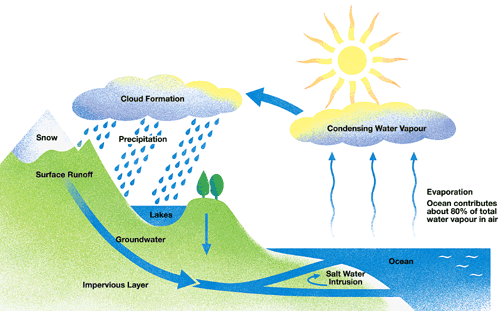IELTS writing task 1 diagrams must be clearly organised with logical paragraphs. This is part of the marking criteria of Coherence and Cohesion which is 25% of your marks. Most IELTS diagrams show a type of process which is divided into stages or given as a cycle. Also remember that writing task 1 is a report, not an essay.
You must organise your IELTS diagram into different paragraphs. Look at the process below and then answer the questions to learn about organising information.
IELTS Water Cycle Diagram:
Source: Diagram not designed by IELTS Liz.
Questions
Learn to analyse and organise your IELTS diagram by answering the following questions:
- How many paragraphs would you have in your report?
- Tips: Never have only one body paragraph.
- What information would you put in each paragraph?
- Tip: Use the arrows and always organise the information logically.
Answers
Read the answers very carefully and look at each point given in the diagram. Click below to reveal the answers:
Answers1. There should be 4 paragraphs for this report.
2. You should put the following information in each paragraph:
- Introduction: You need to introduce the content of the diagram (the process of the water cycle).
- Overview: Put the key stages in this statement (a continual cycle of evaporation, cloud formation, rain and water returning to the sea).
- Body paragraph A: Water in the ocean, evaporation, condensing water vapour and cloud formation.
- Body Paragraph B: Precipitation, rain or snow, lakes, surface run off, ground water, impervious layer and salt water intrusion. You also need to note that at the water cycle starts again as the water returns to the ocean.
- For the body paragraphs, you need to describe each stage in detail using full sentences linked together. You should divide the body into two or three paragraphs for all diagrams.
Example Introduction and Overview
The diagram illustrates the key stages in the water cycle.
Overall, the water cycle is a continual process of water evaporating and forming clouds which then return the water to the land and sea in the form of rain.
- Note: You can see that the introduction is short and brief. You can see that the overview contains the key words as well as the key stages in summary.
- It is possible to put these two sentences into one paragraph.
.
IELTS Writing Task 1
For writing task 1 model answers and more tips, see this page: IELTS Writing Task 1 Model Answers & Tips
All the best
Liz
.









hiie Liz,
The diagram gives information about the process of water cycle and how water is replenished back in different forms on earth.
Overall, the diagram explains the cyclic pattern in which water is maintained on earth. This happens through four stages, that is , evaporation , condensation,precipitation and water returning back to ground and sea.
Initially, the ocean, the huge water bodies due to the conventional heating method releases water vapour which accounts for 60% of the total water vapour in air. This process is called evaporation.This leads to condensation wherein clouds are formed due to the settling of the steam in the cooler areas of the atmosphere. When the water droplets can no longer be suspended in the clouds ,they descend in the form of rain. It is the third step of the water cycle and is called precipitation.
In the higher altitudes, precipitation can take the form of snow which results in snow capped mountains. The snow is gradually melted due to the sun’s heat. Both the surface run off post-raining and melted snow leads to ground water recharge. The water is drained into the ocean resulting in salt water intrusion due to the impervious layer of land.This final stage marks the end of water cycle with water being restored to its original state.
I understand that Liz you dont review and might be occupied if at all you get sometime , i would be happy to have some feedbacks for improvement. Thanks for always helping with your informative videos and this blog in particular.
I do have a little bit of time today for a quick comment. You have repetitive information in the introduction and overview which will lower your score. The overview isn’t about a description, it’s about presenting the key stages of the diagram. The introduction provides a brief description. IELTS reports are marked in a specific way. They should be highly focused with no repeating information. Given that your report is over 210 words, this is an issue. You should be aiming for between 170 and 190 words. More is not better with IELTS. Otherwise, you are doing very well.
The diagram illustrates the water cycle, depicting the movement of water through various stages on sunny days.
Overall, the water cycle comprises four stages, evaporation, cloud formation, rainfall, and water returning. This continous process is driven by solar(thermal) energy, primarily involving the ocean and atmospheric interactions.
In the first stage, water from the ocean, which contributes approximately 80% of the water vapour in air, evaporates due to thermal energy. Next, the water vapor rises, cools, and condenses in the atmosphere, which finally forming clouds.
Subsequently(afterwards), clouds produce precipitation in the form of rain, which falls onto land, replenishing lakes and rivers.Furthermore, snow produce water after it melted, after which keep flowing by surface runoff. During this process, salt water are combined fresh water flowing into the ocean. This return of water to the ocean restarts the water cycle system.
I truly think this one is tough. I might not complete this type of report within 20 minutes.
The diagram illustrates the process led involved in the water cycle.
Overall, the water cycle is a continual process of water evaporation and cloud formation which returns water to the land and sea in the form of rain.
Initially, water from the ocean which contributes about 80% of the total water vapor in the air evaporates and condenses in the sky, which forms clouds through the help of the sun.
Then, precipitation occurs in either rain or snow form back to the lakes and goes through the surface runoff, move underground and collide with the impervious layers to form the salt water intrusion. The water returns to the ocean and the cycle repeats itself all over again as it is a continuous process.
The diagram illustrates the stages of the water from evaporation to flow of water stored in the ocean for further use.
Overall,in the water cycle there are three main stages namely,evaporation,condensation and precipitation.
Intially the Ocean, where it contains the salt water which provides 80% approximately of the total water vapour through air (evaporation) and has been condensing the vapour by the sun ,the clouds can be formed the water droplets can be released from the clouds(precipitation) on to the ground
Secondly,The rain water can be stored in to the ground and water storages in the lakes the plants and trees can be observed the rain water with the help of the impervious layer ,salt water intrusion can be done in the ocean and it is a continuous process .
The diagram given below illustrates the key stages in the water cycle.
Overall, it can be seen that cycle includes six main stages such as salt water intrusion, evaporation, condensing water vapour, cloud formation, precipitation, collecting on a surface or in the reservoirs. All these processes have their own impact on nature, for instance, there is snow formation produced.
The process starts with evaporation from surface and water reservoirs, predominantly from the ocean, which contributes around 80% of total water vapour in air. Thereafter, this vapour is condensed and formed into the clouds. Under the Sun rays influence, collected in clouds in aggregate gas form water is converted into liquid.
Cycle continues with various precipitations. It snows on the mountain peaks, where it’s usually freezing, creating a snow coverage and it rains everywhere else to water the plants and trees. Some water is collected under (groundwater) and on the surface or runs down the mountains and the impervious layer then, reaching reservoirs (surface runoff). It’s also crucial to mention that at the last phase there is a salt water intrusion (when liquid is evaporated and salt stays on the surface). Then the cycle starts again.
Just a quick comment for you. Salt water intrusion is when salt water enters into fresh water (the salt water intrudes into fresh water). So, in the diagram, you can see that some of the salt water from the ocean is entering the river, which contains fresh water. If you are not sure of the meaning of something in a diagram, it’s easier just to write “salt water intrusion occurs” instead of explaining something that you might get wrong. It isn’t really necessary to understand all the words in a diagram to be able to write a coherent sentence with a suitable verb to match the noun.
The diagram illustrates the key stages of the water cycle.
Overall, the water cycle is a continuous process of evaporation and cloud formation which return the water to the land and sea in the form of rain.
Initially, the water from ocean evaporates and condenses as a water vapor. The overwhelming majority (approximately 80%) of them in the atmosphere originates from the ocean. Under the sun heating, the water vapor transforms into a cloud. The water returns to the land and lakes as the precipitation from a cloud.
While the rainwater that landed on hills or lakes directly transfers deeper into underground until eventually becomes groundwater, the rainwater that dropped on a high altitude place ends up as a snow and then by surface runoff reaches the same destination. Next, the groundwater travels in an impervious layer and proceeds under self water intrusion process. Finally, the groundwater reaches the ocean, from which the cycle begins again.
The aim of my website isn’t to provide feedback, but I do have time today for a few points:
1) Great writing. Your grammar is very good. The report is well structured. The overview is well written. However, there are just a few vocabulary errors to fix:
2) vapour is uncountable so you can’t write “a water vapour”, you just write “condenses as water vapour” without any article (a/the). It also means you can’t use “them” in the following sentence.
3) “sun heating” should either be “the Sun’s heat” or “heat from the Sun”. The word “Sun” should be capitalised because all unique items are capitalised such as “the Sun” and “the Moon” when writing about our Sun or our Moon specifically. However, if we are writing about another planet and its sun or many suns, then it is without a capital letter.
Thanks, Liz. I see where I made a mistake. I haven’t realize until your comment that vapour is essentially a gas. Therefore, it should be uncountable. What surprised me most was your comment that all unique items should be capitalized. It is great that there is such a site that helps students prepare for IELTS for free. I really appreciate it.
You’re welcome. I love that people can come here to learn more 🙂
Thank you Liz for detailed explanation. Could we use such overview or this is too long:
Overall, the water cycle is a continuous process consisting of six main stages, starting with the evaporation of water from the ocean, followed by condensation and cloud formation, leading to precipitation. The water then flows as surface runoff and undergoes saltwater intrusion, and the cycle starts again.
It’s quite long and contains a lot of small details. Your aim isn’t to summarise all steps but to highlight the key stages. You do get a lower score if you get lost in detail and can’t present key features.
For example: Overall, evaporation and transpiration lead to the formation of clouds and rain, which then falls on the surface of the land and water. This eventually leads back to the ocean and the cycle starts again.
Thanks Liz, for a quick response. I got confused specially in case of a circular diagram, but thanks for clarifying.
Can I write overview like this:
Overall, the water cycle consists of six stages. These stages includes eveproration of water from ocean, condensation, cloud formation, precipitation, surface runoff, and salt water instrusion.
This also isn’t an option. All you’ve done is list words. You are being marked on your ability to select and present key features – not list them. I’m glad you are asking these questions because it’s the only way to learn.
Thanks again.
The diagram illustrates the key events involved in the water cycle.
Overall, the water cyle is a continous process in which the water gets evaporated to form clouds which then return the water to the land and the sea in the form of rain.
Firstly, the water from the waterbodies gets evaporated by the heat of the sun, among which the ocean contributes about 80% of total water vapour in air. Condensation of these water vapours result in the formation of clouds in the sky, which occurs repeatedly and continously until the cloud becomes too heavy to hold any more water droplets.
At this stage, the water droplets from the clouds precipitate as rain and fill up the lakes and ponds, which will eventually replenish the groundwater. Similarly, water melted from the snow runs off the surface and joins the groundwater. Finally, water from the impervious layer of soil leads the water back into the ocean. Then, the first step of the process beings again to keep this water cycle a continous process.
The diagram illustrates how ocean water is continually recycled through the atmosphere and back to the ocean. Overall, ocean water amounts to about 80% of atmospheric water in total and is taken up into the air as vapor, which condenses, form clouds, released as rain, and recycled back into the ocean through various channels.
The stages of water cycles begin with ocean water taken up to the atmosphere through a process called evaporation. Sunlight contributes to this stage in that energy released traps ocean water into the clouds in the form of vapor and the vapor thickens the cloud. When the atmosphere is rid of energy in form of sunlight, the thick cloud precipitates, releasing the trapped water, as rain or snow on surface of the earth, plants, and lakes.
The rainwater that fell on plants is soaked into the inner layer of soil. Additionally, rainwater collected as snow melts and runs off the earth surface into the ocean and the cycle is repeated.
The given diagram shows the life cycle process of water with the effect of temperature.
Overall, it is illustrated how water from the ocean changes its state at four different stages by converting into water vapors, snow, rain and ground water to keep the cycle flowing for needs of the ecosystem.
At first ocean water transforms into water vapors due to heat from the sun. The water vapors are stored in the clouds. Secondly, the water filled clouds are carried to mountainous regions by the wind. Here the vapors fall in the form of precipitation and snow. Some of this rain and snow water gets collected in lakes, while the majority runoffs the surface in the form of groundwater through the impervious layer. Lastly, water in the ground goes through saltwater intrusion near the coast and is then mixed back into the ocean to keep this cycle going. It is important to note that primary source of water vapors in the air is the ocean.
Be careful adding information that isn’t given. This cycle is something that is part of the eco system and it’s a very important part. But this information isn’t given. You’ve added that yourself. This will cause you to lose marks. Only state what is given in the diagram.
The diagram described the formation and processes involved in the water cycle.
Overall, water on land moves in a continuous cycle and processes like evaporation, condensation and precipitation and the whole cycle is aided by the sun.
in details, the heat from the sun rays evaporates some of the water into water vapour. Evaporated water from the sea sums up to about 80% of the total atmospheric water vapour . Through condensation process, water vapour is condensed to form clouds. Clouds formed are poured down to the land in the form of precipitation or snow.
Snow and water precipitations that hit the ground run off into the ground water. Ground. water in the impervious layer mix with salt water runs to the sea. This cycle continues over and over again
The diagram demonstrates the main steps involved in the water cycle.
Overall, water goes through an ongoing process starting at evaporation of water coming from the ocean. This evaporation leads to cloud formation and precipitation of water to the land, to finally make its way back to the ocean.
First, the heat of the rays of the sun causes ocean water to evaporate which makes up around 80% of the total water vapor in the air. Then, this hot water vapor coming from the ocean experiences a condensation process that causes the formation of clouds.
Next, when enough water vapor accumulates in the clouds it leads to precipitation. Some of the rainwater that falls to the earth contributes to the formation of lakes. Another portion of the water, both from the rain and from the melting of snow seeps into the ground as groundwater. This groundwater runs down through the impervious layer to finally get mixed with salt water and return to the ocean to start the process again.
THE DIAGRAM SHOWS HOW WATER IS BEING CIRCULATED BACK TO THE OCEAN THROUGH EVAPORATION AND PRECIPITATION. OVERALL IT SHOWS CONDENSATION STARTS IN THE OCEAN ON A SUNNY DAY WHEN AIR RISES AND PRECIPITATION IN THE FORM OF RAIN WHEN THE WATER IS RELEASED BACK TO EARTH.
THE OCEAN CONTRIBUTED ABOUT 80% OF TOTAL WATER VAPOUR IN THE AIR. WITH THE HELP OF A BRIGHT HOT SUNNY DAY, THE CONDENSED WATER VAPOUR RISE TO THE AIR AND THROUGH THIS PROCESS CAUSED THE FORMATION OF CLOUDS.
WHEN ENOUGH WATER VAPOUR ACCUMULATES IN THE CLOUDS, THE RAIN WILL START POURING. RAINWATER FALLS DOWN TO THE EARTH IN THE FORM OF PRECIPITATION. SOME OF THE RAINWATER GETS CAPTURED BY LAKES, A PORTION UNDERGOES SURFACE RUNOFF AND SEEPS INTO THE GROUND AS GROUNDWATER. WHEN SNOW MELTS FROM THE MOUNTAINS, ITS WATER WILL ALSO SEEP INTO THE GROUND.
THE IMPERVIOUS LAYER OF THE EARTH HINDERS THE WATER FROM GOING DEEPER THE SURFACE HENCE LEADING THE RAINWATER ALONG WITH INTRUSION OF SALT WATERI TO FLOW BACK TO THE OCEAN WHERE THE WATER INITIALLY CAME FROM. THIS COMPLETES THE PROCESS OF WATER BEING RECYCLED IN THE ENVIRONMENT.
The diagram shows the wheel of life for water in which it undergoes different phases that, as a constant cycle, start from evaporation to precipitation.
Overall, this continual cycle can be divided into three prominent stages namely evaporation, condensation, and finally precipitation. This process repeats in this manner throughout.
Initially, using the Sunlight, Water from Ocean will be evaporated and subsequently rises to the sky in the form of vapor. It is pertinent to note that although there are different sources from which water-vapour is formed, Oceans contribute nearly 80% to the formation. From this point, water vapor in the air will be subjected to condensation through which clouds are formed.
Water from both melting of snow and precipitation of clouds either gets collected in the form of lakes or runs down the surface in the form of groundwater. Through an Imperious layer, Groundwater along with saltwater, from the intrusion of ocean water, moves back to the Ocean and entire process repeats again to form a cycle .
The diagram picture illustrates the main water cycle process in the earth, how it’s goes from the ocean to evaporate then rain and end to ocean again.
Overall, water cycle it’s a constant process which starts with evaporation of ocean water and complete it’s journey of remaining water to the seas or the oceans.
Oceans are the biggest salty water container in the earth which it’s responsible for 80% of evaporation process, the rain fall on the mountains, heights, flat earth and others for forming lakes and rivers which it’s important for humans, animals and planets, the extra water goes again to the oceans to repeat the previous cycle again and again.
The diagram shows the process and activities on the Earth sùrface by which water is continuously circulated.
Overall, the water cycle is sustained by the continuous evaporation of water, mainly from surfaces of water bodies, the accompanying cloud formation in the atmosphere as a result of water saturation and condensation to vapour which is precipitates to liquid falling back to the lakes, mountain and other parts of the biosphere as rain.
The ocean contributes 80% of the total evaporated water from the lower spheres of the Earth. At elevated temperatures of the sun, evaporation is at its peak, precipitating water vapors to rain water. Rain falls to the surfaces of lakes, mountains and even bare lands on valleys. Run offs from snows formed at mountain tops and lands percolates the impervious ground layer and filters back to the sea when there is an intrusion. This cycle is repeated to give rise to the water cycle diagram on Earth surface.
The picture illustrates the key stages in the water cycle. The stages that is familiar would be evaporation, condensation, cloud formation then precipitation. Water cycle is a continual process of water and forming clouds which then return the water to the land and sea in the form of rain.
Ocean is the biggest body of water in the earth and it contributes about 80% of total water vapour in air. Once the water from the sea evaporates it fills the clouds through condensation of water vapour, thus the cloud formation. These cloud formations are filled with evaporated water from the sea that will serves as rain during a rainfall.
After the forming of clouds, precipitation will follow. The water that produces by precipitation will be the rain or snow. Rainwater could be stuck in the lakes or just flows underneath the soil through the surface underground. Some rainwater also goes down to the impervious layer of the ground. In addition, some rain water also goes back to the ocean with salt water intrusion and the process starts again as the water returns to the ocean.
The diagram illustrates the water cycle model on Earth.
Overall, the cycle is responsible for the rainfall we get. This process involves different stages such as evaporation, condensation, cloud formation and precipitation.
Initially, the water from water bodies evaporate due to the heat of the sun, it is to be noted that almost 80% of the water vapour is contributed by the oceans. Secondly, the water vapour condenses to form the clouds and this process is known as condensation.
Finally, when the clouds are heavily dense it gives water in the form of rain back to the water sources such as lakes. This process is usually called as precipitation. Gradually, the groundwater, the water from mountain snow and the surface run off water all flow through the impervious layer of earth to join the ocean, where the sweet water is intruded with the salt water. And the above cycle repeats.
The diagram illustrates the cycle process of water on earth. The phenomenon is described in between ocean, lakes, and mountain regions, which contributes to the various steps occurring in the water cycle phenomenon.
Overall, three major phenomena are happening throughout the water cycle process, these are Evaporation, Condensation, and Precipitation. The water is evaporated to condense and later on precipitated to complete the entire water cycle process.
To begin with, the evaporation step is backed up majorly by the water present in the ocean (80%). The heat from the sun is used to form water vapors from the ocean, which is condensed to form clouds by the condensation process. Once, there is enough cloud formed, it gets blocked by the massive mountain regions which lead to precipitation.
During precipitation, the water returns to the earth through the rain to fill the lakes and ocean. However, this is not the only contributor, there is surface runoff of groundwater from mountain regions, Also the groundwater increases from the water coming from trees too. This creates an impervious layer, which flows back to the ocean. The merging of water from lake and ocean is known as saltwater intrusion, with this the water cycle phenomenon is completed.
The diagram demonstrates the key stages in the water cycle on earth.
All in all , water cycle is a constant process which starts with the evaporation of water from oceans and culminating in the precipitation and return journey of remaining water to the seas or oceans.
The formation of majority of water vapors about four fifth allocated to atmosphere by oceans. Afterwards, it condenses to form giant clouds, which ended up in rain or precipitation. The rainwater is distributed among different sources on earth.
Some water again drain out in lakes and other water bodies. Some volume of it getting absorbed by plants .little bit of it goes to the impervious layer of earth . The water from upper regions like mountains , also contributes to soil erosion. In this way, this process keep on occurring in biosphere.
Wow this is an amazing answer. I hope I also have that wide idea of yours
This is really helpful Parminder, Thank you.
Thank you for your all information Liz,
Did anyone write full essay by using this introduction?
I’ve tried a little, but i’m not sure it’s completely correct.
Can you please share?
Thanks for sharing Liz. Tomorrow is my exam and this representation cleared lots of doubts. Wish me good luck.
Thanks for sharing.
Hi Liz,
Thanks a ton for your advices. Would you please help me with a detailed orientation on writing task 2 …It will be great if you can share a broad guidelines for writing the intro , main ideas and sub ideas and the conclusion.
Regards
Free tips: https://ieltsliz.com/ielts-writing-task-2/. Advanced lessons: https://elizabethferguson.podia.com/
This IELTS water cycle diagram is the example for Academic or General Training module
See this page: https://ieltsliz.com/ielts-gt-academic-writing-differences/
Thanks Liz. You are really good at it. You simplified it in a way I love to learn.
Hi Liz,
Thank you very much for your great lessons.
Could you please do some writing lessons on illustrating tables, maps, specially process (ex: life cycle of butterfly).
Thanks
There are over 300 pages of lessons like this one for IELTS. Go to the RED BAR and click the section you want to study. This is the main writing task 1 page: https://ieltsliz.com/ielts-writing-task-1-lessons-and-tips/
Thank you Liz for this informative post. I really like the thoroughness with which you approach this task as well as the invaluable tips you provide.